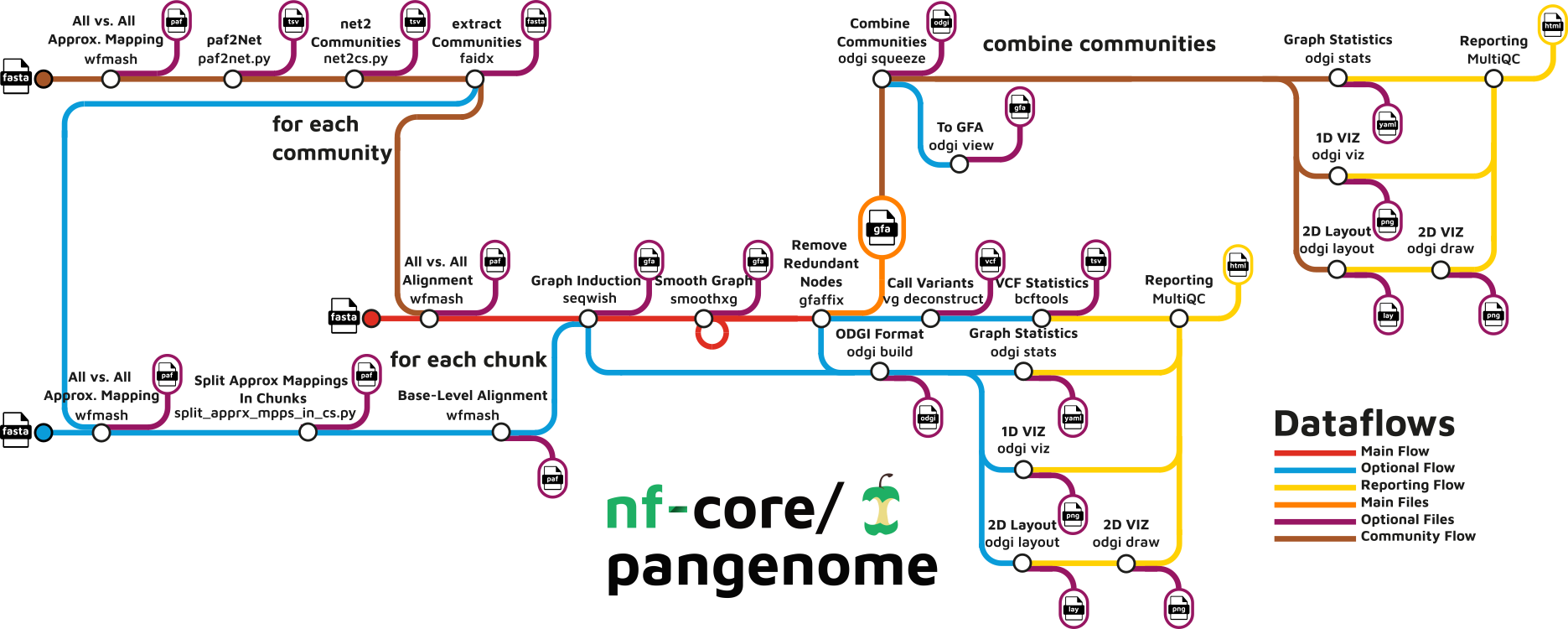nf-core/pangenome
Renders a collection of sequences into a pangenome graph. https://doi.org/10.1093/bioinformatics/btae609.
Introduction
nf-core/pangenome is a bioinformatics best-practice analysis pipeline for pangenome graph construction. The pipeline renders a collection of sequences into a pangenome graph. Its goal is to build a graph that is locally directed and acyclic while preserving large-scale variation. Maintaining local linearity is important for interpretation, visualization, mapping, comparative genomics, and reuse of pangenome graphs.
The pipeline is built using Nextflow, a workflow tool to run tasks across multiple compute infrastructures in a very portable manner. It uses Docker/Singularity containers making installation trivial and results highly reproducible. The Nextflow DSL2 implementation of this pipeline uses one container per process which makes it much easier to maintain and update software dependencies. Where possible, these processes have been submitted to and installed from nf-core/modules in order to make them available to all nf-core pipelines, and to everyone within the Nextflow community!
On release, automated continuous integration tests run the pipeline on a full-sized dataset on the AWS cloud infrastructure. This ensures that the pipeline runs on AWS, has sensible resource allocation defaults set to run on real-world datasets, and permits the persistent storage of results to benchmark between pipeline releases and other analysis sources. The results obtained from the full-sized test can be viewed on the nf-core website.

Pipeline summary
- All versus all alignment (
WFMASH) - Graph induction (
SEQWISH) - Graph normalization (
SMOOTHXG) - Remove redundancy (
GFAFFIX) - Graph statistics and qualitative visualizations (
ODGI) - Combine diagnostic information into a report (
MULTIQC)
Usage
If you are new to Nextflow and nf-core, please refer to this page on how to set-up Nextflow. Make sure to test your setup with -profile test before running the workflow on actual data.
Now, you can run the pipeline using:
nextflow run nf-core/pangenome -r dev --input <BGZIPPED_FASTA> --n_haplotypes <NUM_HAPS_IN_FASTA> --outdir <OUTDIR> -profile <docker/singularity/podman/shifter/charliecloud/conda/institute>Please provide pipeline parameters via the CLI or Nextflow -params-file option. Custom config files including those provided by the -c Nextflow option can be used to provide any configuration except for parameters; see docs.
For more details and further functionality, please refer to the usage documentation and the parameter documentation.
Advantages over PGGB
This Nextflow pipeline version’s major advantage is that it can distribute the usually computationally heavy all versus all alignment step across a whole cluster. It is capable of splitting the initial approximate alignments into problems of equal size. The base-level alignments are then distributed across several processes. Assuming you have a cluster with 10 nodes and you are the only one using it, we would recommend to set --wfmash_chunks 10.
If you have a cluster with 20 nodes, but you have to share it with others, maybe setting it to --wfmash_chunks 10 could be a good fit, because then you don’t have to wait too long for your jobs to finish.
Pipeline output
To see the results of an example test run with a full size dataset refer to the results tab on the nf-core website pipeline page. For more details about the output files and reports, please refer to the output documentation.
Credits
nf-core/pangenome was originally adapted from PGGB by Simon Heumos, Michael Heuer.
Simon Heumos is currently the sole developer.
Many thanks to all who have helped out and contributed along the way, including (but not limited to)*:
* Listed in alphabetical order
Acknowledgments
Contributions and Support
If you would like to contribute to this pipeline, please see the contributing guidelines.
For further information or help, don’t hesitate to get in touch on the Slack #pangenome channel (you can join with this invite), or contact me Simon Heumos.
Citations
If you use nf-core/pangenome for your analysis, please cite the Bioinformatics manuscript using the following doi: 10.1093/bioinformatics/btae609. You can also cite the current release’s doi: 10.5281/zenodo.8202636.
An extensive list of references for the tools used by the pipeline can be found in the CITATIONS.md file.
You can cite the nf-core publication as follows:
The nf-core framework for community-curated bioinformatics pipelines.
Philip Ewels, Alexander Peltzer, Sven Fillinger, Harshil Patel, Johannes Alneberg, Andreas Wilm, Maxime Ulysse Garcia, Paolo Di Tommaso & Sven Nahnsen.
Nat Biotechnol. 2020 Feb 13. doi: 10.1038/s41587-020-0439-x.